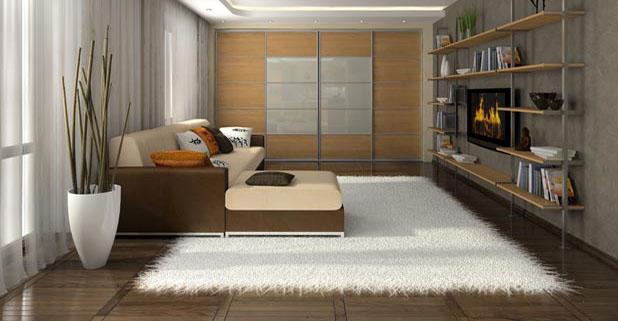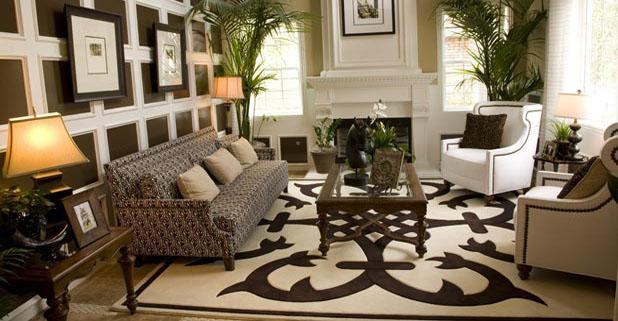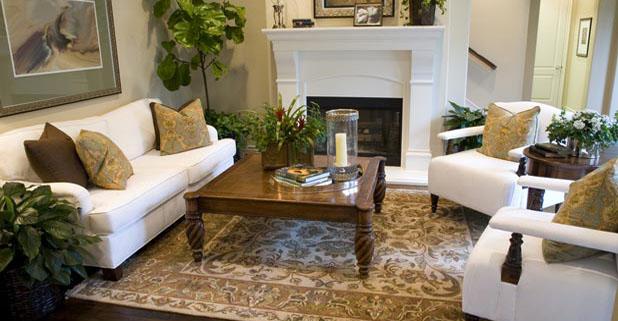 Long before the term “wall-to-wall” was invented, area rugs graced the floors of human dwellings. The original area rugs may have been lion skins — and they may have done double duty as beds, but it was an area rug, just the same.
Long before the term “wall-to-wall” was invented, area rugs graced the floors of human dwellings. The original area rugs may have been lion skins — and they may have done double duty as beds, but it was an area rug, just the same.
Later on, our ancestors learned to weave rushes and grasses to make mats. Once we started domesticating sheep, we learned to spin their wool into yarns and weave them.
Some time before 2000 BC, the nomadic tribes of Asia began making rugs in great numbers. The Mongols gave us pile rugs, but the Persians turned rug making into an art form. European rug weaving probably started about 1000 AD in Spain. Intrepid explorer Marco Polo influenced rug making with his discoveries of new materials and techniques in China in the late 1200s. As civilization has marched forward there’s likely been a good rug underfoot.
Area rugs are tremendously versatile. With the appropriate pad, area rugs work on any type of flooring and in any room. The results are magical. Area rugs offer unlimited combinations of color, texture, pattern and placement. They are the only flooring product that you can easily install, then pick up and move!
Today’s area rugs are most often machine-made with sophisticated design patterns on computerized looms that can imitate the more intricate handmade rugs — but at greatly reduced costs. They are generally made out of wool, silk, (or a blend of wool/silk), olefin (polypropylene), or nylon —occasionally cotton, and even bamboo.
Wool and silk antique and modern area rugs rule the high end of the market. More moderately priced rugs are manufactured from heat-set olefin, which looks like wool and cleans easily.
Are you looking for an investment, a family heirloom, a practical room addition or a fun accessory? Whatever your need or intention, you simply can’t go wrong with an area rug.
 Area rugs offer the most variety in floor coverings. But before you buy, you need to know just a couple more things about them — other than that they can define a space and elevate your décor. Whether you choose handmade or machine made, antique or thoroughly modern, you need to consider these questions:
Area rugs offer the most variety in floor coverings. But before you buy, you need to know just a couple more things about them — other than that they can define a space and elevate your décor. Whether you choose handmade or machine made, antique or thoroughly modern, you need to consider these questions:
What Size And Shape?
Area rugs are made in standard and non-standard sizes and they can be rectangular (most common), round, square, oval, octagonal or long and narrow for runners. The most common sizes are 2’x3’, 4’x6’, 5’x8’, 6’x9’, 8’x10’ and up.
Choosing the correct size area rug depends on the dimensions of the space you want to cover. Here are some hints on how to figure out what size rug you need.
If you are thinking square or rectangle, place a piece of paper where each of the corners will fall in the area you wish to cover. Measure the space and adjust the “corners” as needed to make the space larger or smaller given the standard rug sizes. You’ll probably have to go up or down a few inches. Take your time.
If you’re considering a round rug, you can run a piece of tape from the center of the space you want to cover to the outside edge. Measure it. This gives you the radius of the circle. Double it and you have the diameter. Round rugs are sold by the diameter. Again, you may have to adjust it up or down to reach a standard rug size.
Oblongs or ovals are measured like rectangles — by the length of the longest part and the width of the widest part. You can run a piece of tape on your floor to determine the length and a second to determine the width. You will have a large cross taped to your floor, but it will tell you how big an oblong you need to cover the space.
If you choose to cover the whole room with your area rug, it is best to leave a 12-inch to 15-inch border of flooring exposed to frame your rug.
Rugs that are destined to go under the dining room table should be large enough so that when seated at the table, the back legs of your guests’ chairs are on the rug with enough space to push back and stand up. This way, no one has to go over the edge to getup from the table.
One more thing. When you buy, bring a tape measure. A 9’x12’ rug often isn’t. Like textile clothing sizes, they need to be “tried-on”, or at least measured so you know what true size you are actually buying, particularly if it is a handmade rug. Don’t be surprised if it’s a little short in each direction.
What Color?
Color is at least as important for an area rug as how it’s made. The combination of color, design and setting (your room) all come together to create your own personal artistic statement.
Area rugs don’t have to match the colors of the room precisely. Great interior design often features combinations of colors that either contrast or compliment a room’s primary color scheme. But a good rule of thumb is to stick to one primary shade and two additional colors.
What Pattern?
Pattern is divided into three categories in the rug industry: curvilinear, geometric and pictorial. Knowing what kind of pattern you prefer can help narrow the field a bit.
Curvilinear literally means curved lines. It refers to patterns with swirl, arc and bows.
Geometric refers to patterns based on simple geometric shapes such as, lines, triangles, squares and rectangles.
Pictorial, the smallest group, refers to patterns that portray people, animals and scenes.
Style
Style is such an ambiguous idea. It simply means a distinctive manner of expression. Over time, names get attached to the word style: Contemporary style. Classical style. Art Deco style. Your style can draw on bits and pieces of all of these and more. It is a personal expression of the way you want to live your life.
Rugs also have acquired styles: Natural, Navajo, Oriental, Persian, Chinese, Turkoman, Caucasian, Tibetan, Indian and Colonial, just to name just a few. No one expects you to know all of these or even some of these. You need to know what you like. If you do some research and find an image of an area rug you find attractive, take it to your retailer and then you can discuss what style it is. It’s another way of beginning the search.
What Now?
Once you know the direction you are traveling, there is only one final lesson. Know and trust your retailer. If you are shopping for antique rugs, this is fundamentally important. All investments should be made with the help of a knowledgeable counselor.
If this is not an investment, then what you have learned here will guide you to buying the best area rug in the right style for the right price.
Finally, Be Calculating!
Figure the total cost of rug ownership. The price on the tag of the rug you’re buying is just one component of your cost. You don’t want any of those Aha! moments, right?
Product Delivery
Delivering your rug and padding to your home may or may not be included in the price you’re quoted. Ask.
Financing
Many retailers offer financing. Financing is not an additional cost, but rather an option of payment. It usually requires interest payments and that can add to the total cost.
Remember to ask your retailer about the manufacturer’s warranty and care guide. You will want directions on how frequently your rug should be cleaned and some indication of the cost to clean it.
Walk All Over That Rug.
It’s important to understand that even though a handmade rug is valuable, it’s made to be used. Don’t keep if covered in plastic like Aunt Edna’s sitting room sofa. With usage, most hand made rugs gain a certain patina that enhances their beauty and value. If you’re not going to enjoy it, why have it?
Vacuuming Is Good
You should vacuum or sweep your area rug as you would wall-to-wall carpeting. Watch the fringes. You don’t want to have to pull them out of the vacuum cleaner. Handmade area rugs can benefit from being turned over and vacuumed. Lift the rug up carefully and you will see all the dirt that has filtered down. Yuck!
Turn, Turn, Turn
Rotating your rug occasionally (annually) will help even wear patterns and prevent uneven fading. When rugs are exposed to the sun evenly, the colors harmonize and the rug ages nicely. If parts of the rug receive too much or too little of sun, one side might fade faster than the other.
 See Spot? Go!
See Spot? Go!
Clean your area rug immediately after a spill. A water spill should be dried with a hairdryer set on a warm temperature. Try to dry both sides of the rug if possible.
Anything else should first be blotted with paper towels to absorb as much as possible, and then apply salt or baking soda to the spot for a few minutes to absorb the rest. Once it dries, vacuum off the salt or baking soda. Professional grade rug cleaners are available. Be sure to test for color fastness before using.
Take the rug to a professional handmade rug cleaner to deal with old or persistent stains. Do not try to clean it yourself. You might make it worse!
Read The Labels And Listen To The Pros
If you purchased a handmade rug, it’s best to have it cleaned by professionals. If you have a machine made rug, look to the manufacturer for the best way to clean it. Some can be machine washed. Others can be scrubbed by hand and dried outside.
Does Your Pad Need Padding?
Consult with your retailer about the proper padding to be placed under the area rug you choose. A pad can help stabilize and protect your rug. Some rugs come with a non-skid backing or a nice foam padding already attached.
Storing
If your area rug needs to be stored for a long time in a place without exposure to light or air, first vacuum it or get it professionally cleaned. For handmade rugs and those made of natural fibers, you might consider packing it with mothballs to protect against insect damage.
Never fold your rug — roll it. And store it in a dry location.
Rug Repair
Repairing a handmade rug is an art form in and of itself. It is time consuming and labor intensive and therefore, often costly. Get the opinion of a professional before you have work done on a handmade rug — and be sure to use a reputable repairman.
